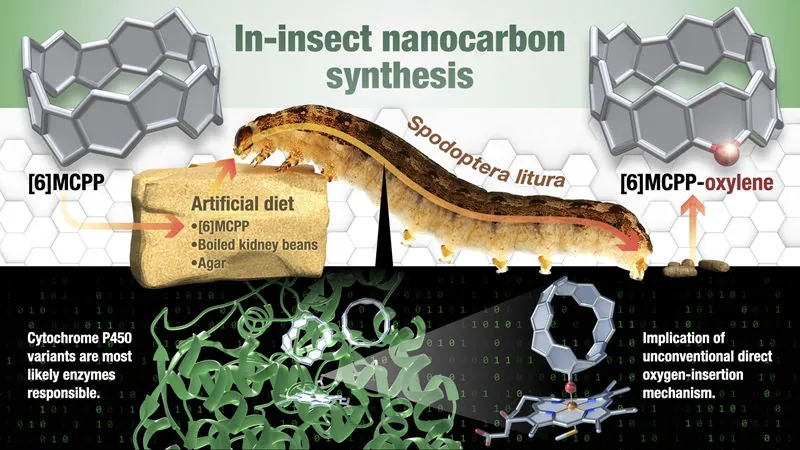
Insects: The Surprising New Factories for Advanced Molecule Creation!
2025-06-10
Author: Michael
Revolutionizing Chemical Engineering with Tiny Helpers
Imagine harnessing the incredible biological processes of insects to manufacture cutting-edge materials! A team at RIKEN is taking bold strides in this direction by transforming insects into living factories capable of creating complex molecular structures known as nanocarbons.
The Magic of Molecular Nanocarbons
Molecular nanocarbons are incredibly small yet boast remarkable properties: they are strong, conductive, and even fluorescent. These traits make them prime candidates for groundbreaking applications in fields like aerospace, lightweight power sources, and advanced electronics. However, uniting carbon atoms in precise configurations within a lab has proven to be a significant challenge.
A Bold Experiment: Feeding Nanocarbons to Insects
Enter the innovative idea from researcher Itami and his team: what if they could feed these nanocarbons to insects? Itami notes that certain plant-eating insects, such as grasshoppers and caterpillars, possess extraordinary metabolic systems adept at breaking down foreign substances. The researchers proposed that these insects might perform chemical transformations on nanocarbons that conventional laboratory techniques can’t replicate.
From Pests to Partners: The Tobacco Cutworm's Transformation
The team conducted tests using tobacco cutworm caterpillars, notorious agricultural pests with well-understood metabolic pathways. When the caterpillars were fed a diet including a specific molecular nanocarbon called [6]MCPP, something remarkable happened. Within just 48 hours, their droppings revealed the creation of a new fluorescent molecule called [6]MCPP-oxylene, which incorporated an oxygen atom thanks to the caterpillar's metabolic magic.
Unveiling the Chemistry Behind the Marvel
Through advanced techniques such as mass spectrometry and X-ray crystallography, the team identified the structure of [6]MCPP-oxylene and pinpointed two crucial enzymes responsible for this transformation. These findings are groundbreaking, revealing that the enzymes can simultaneously bind multiple molecules and insert oxygen atoms into carbon bonds—a rare feat that’s been nearly impossible to achieve in lab settings.
A New Frontier in Materials Science!
This pioneering research not only redefines how we think about synthesizing materials, but also emphasizes the potential of biological systems—like insects—to drive forward chemistry and synthetic biology. By blending genome editing and directed evolution techniques with in-insect synthesis, the possibilities are vast.
From Villains to Heroes in Agriculture!
Isn’t it incredible? Tobacco cutworms, often deemed the ultimate agricultural foes due to their rapid growth and pesticide resistance, are now emerging as unexpected saviors in the realm of advanced materials. This shocking twist in their role showcases nature’s potential as a collaborator in science.









 Brasil (PT)
Brasil (PT)
 Canada (EN)
Canada (EN)
 Chile (ES)
Chile (ES)
 Česko (CS)
Česko (CS)
 대한민국 (KO)
대한민국 (KO)
 España (ES)
España (ES)
 France (FR)
France (FR)
 Hong Kong (EN)
Hong Kong (EN)
 Italia (IT)
Italia (IT)
 日本 (JA)
日本 (JA)
 Magyarország (HU)
Magyarország (HU)
 Norge (NO)
Norge (NO)
 Polska (PL)
Polska (PL)
 Schweiz (DE)
Schweiz (DE)
 Singapore (EN)
Singapore (EN)
 Sverige (SV)
Sverige (SV)
 Suomi (FI)
Suomi (FI)
 Türkiye (TR)
Türkiye (TR)
 الإمارات العربية المتحدة (AR)
الإمارات العربية المتحدة (AR)